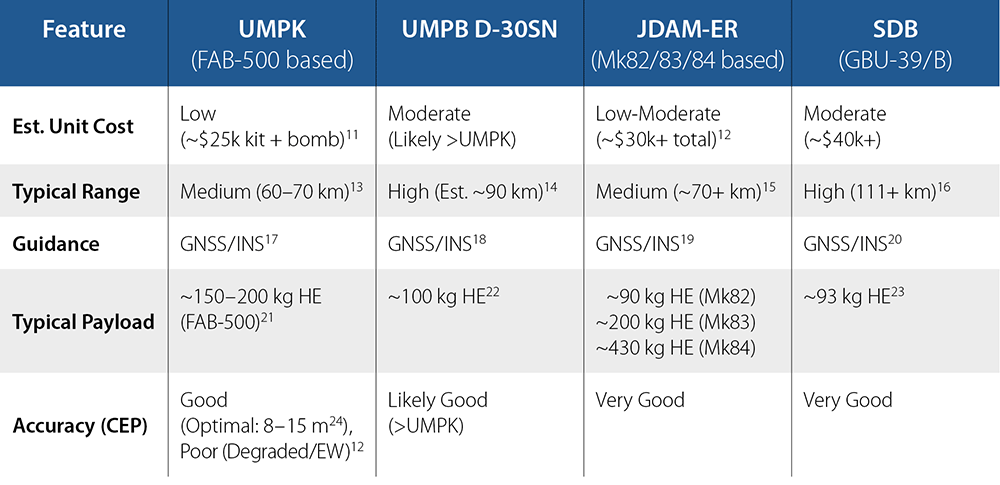Introduction
The Russia-Ukraine war has served as a proving ground for military innovation on both sides of the conflict. While Ukrainian forces pioneered small, unmanned aircraft systems (UAS) technology to stall ground assaults, Russia’s most effective adaptation has been the mass deployment of glide bombs, which have helped Moscow translate small tactical gains into significant strategic challenges for Ukraine. Glide bombs have become a transformative element in the conflict.
A glide bomb is an aerial munition that utilises aerodynamic surfaces, such as wings and control fins, to achieve a significantly greater standoff range than a traditional unguided bomb. Upon release, deployable wings open allowing the munition to enter a controlled glide that converts altitude and airspeed into horizontal distance. Guidance systems, typically a combination of satellite navigation (GPS or GLONASS) and inertial navigation systems (INS), directs the weapon towards its target while the releasing aircraft turns away from the threat.1
This article contends that glide bombs have had a greater battlefield impact than almost any other Russian weapon system due to a confluence of factors: they are cost-effective, particularly when using conversion kits on existing stockpiles of unguided bombs; they deliver substantial payloads; they are sufficiently accurate for many tactical purposes; and critically, they allow launch aircraft to remain at stand-off distances, thereby reducing risk from Ukrainian air defences.2 The tactical, strategic, and psychological impacts of these weapons have been profound. Russia’s employment of these weapons was a significant factor for Ukraine on the Zaporizhzhia front in the summer of 2023, contributed to the fall of Avdiivka in early 2024, and has been a key element applying pressure in battles like Chasiv Yar, a strategic high ground west of Bakhmut, and many other instances throughout the year.3,4,5,6
However, Ukraine’s improving countermeasures reveal the strengths and limitations of the weapon system, presenting valuable lessons to NATO for the use of, and defence against, glide bombs in future conflicts.
Glide Bomb Overview
Glide bombs fall into two categories: traditional bomb bodies fitted with conversion kits, and purpose-built munitions. Conversion kits are add-on packages that modify existing unguided bombs. Notable examples include the US Joint Direct Attack Munition-Extended Range (JDAM-ER) and Russia’s Unified Gliding and Correction Module (UMPK). Purpose-built glide bombs, including the US’s GBU-39 Small Diameter Bomb (SDB) and Russia’s newer Universal Interspecific Glide Munition (UMPB), are designed as integrated glide weapons.
Both types offer the key advantage of increased stand-off range, enabled by aerodynamic surfaces that allow the weapon to glide rather than follow a simple ballistic trajectory. This permits delivery platforms, usually fighters or bombers, to release weapons from outside the ranges of enemy air defences. Ranges vary significantly based on launch altitude and speed, from tens of kilometres to over 100 kilometres for some systems.7 Payloads are scalable for conversion kits (for example, 250kg, 500kg, 1,500kg, or even 3,000kg class bombs) or fixed according to the purpose-designed warhead.8
Today, glide bombs like the JDAM-ER and SDB are common among NATO arsenals, with several other variants in development. For Russia, two specific weapons currently make up most of its inventory.9
Russian Glide Bombs: UMPK and UMPB
Russia’s glide bomb arsenal primarily comprises the UMPK kit and the UMPB munition. The UMPK is an inexpensive conversion kit estimated at around $20,000. It is designed to be strapped onto Soviet-era FAB-series bombs, such as the FAB-500 and FAB-1500, allowing Russia to convert its vast stockpiles of unguided munitions into glide bombs. While cost-effective, early UMPK versions had a crude construction and relied on civilian-grade electronics, exposing production to supply chain vulnerabilities.
Russia seemingly recognised these shortcomings and subsequently manufactured the UMPB D-30SN, a purpose-built glide bomb. It integrates the warhead (reportedly based on the FAB-250) and guidance systems into a more aerodynamically refined package. First observed in Spring 2024, the UMPB is assessed to offer improved ranges, potentially up to 90 km compared to the UMPK’s typical 60–70 km, and may include enhanced resistance to electronic warfare (EW).10
Employment in Ukraine and its Consequences
Early in the war, initial glide bomb expenditure was limited. However, this escalated markedly so that by early 2025 Russia was releasing approximately 3,500 UMPK-equipped bombs per month, or over 100 per day across the front. These weapons have been predominantly used against static targets, overwhelming defences and degrading Ukrainian positions ahead of ground assaults. Russian strikes were particularly concentrated along the eastern and southern front lines and, increasingly, against urban centres like Kharkiv and Sumy.
Russian forces primarily utilise Su-34 ‘Fullback’ fighter-bombers as launch platforms, often carrying four glide bombs per sortie. Su-30SM and Su-35 ‘Flanker-E’ aircraft also employ these weapons.12 These aircraft typically release weapons 35–50 km from the front line, though ranges can extend further with high-altitude launches. While greater stand-off ranges are aerodynamically possible, increased release ranges are likely to enlarge miss distances and complicate targeting.
Operationally, these weapons have enabled Russian forces to achieve tactical successes by providing a means to deliver heavy ordnance from relative safety. In urban warfare scenarios such as Kharkiv, glide bombs have reduced buildings to rubble, denied cover to defenders and produced substantial psychological effects.25,26
This mass employment strategy aims to achieve attrition and create breaches in Ukrainian lines that ground forces can then exploit.27 The systematic destruction of Ukrainian fortifications was a key factor in the Russian capture of Avdiivka and has been instrumental in applying pressure in battles like Chasiv Yar. Glide bombs have also been used to interdict tactical resupply routes and target-hardened command posts and infrastructure.
Table: Comparative Overview of Selected Glide Bombs.
Limitations and Ukrainian Countertactics
Despite their effectiveness, Russian glide bombs have important limitations. Most notably, they are dependent upon Global Navigation Satellite System (GNSS) signals, especially GLONASS, rendering them susceptible to EW. Reports suggest that when GNSS is disrupted, the UMPK’s backup INS is prone to significant inertial drift over the weapon’s flight time, causing it to veer off course in the absence of a stable GNSS signal. Several conversion kit-equipped UMPK have been found on both sides of the battlefield, likely the result of weapons malfunctions or guidance errors that produced large miss distances.28
Furthermore, despite the inherent stand-off ranges afforded by glide bombs, the Su-34s and Su-35s can, and have, been targeted by long-range air defence systems and fighter aircraft. Tactics on both sides have evolved quickly, as have operator proficiency levels, creating a hazardous environment for fighters delivering glide bombs and for those attempting to intercept the bomb droppers.29
Ukraine is actively exploiting such vulnerabilities and evolving tactics to mitigate the glide bomb threat. Electronic warfare has emerged as the most effective countermeasure to glide bomb employment. The Pokrova system and other specialised jammers have reportedly been effective in degrading UMPK accuracy, while the widespread Ukrainian use of dispersion and concealment has complicated Russian efforts to obtain timely and accurate target coordinates. These factors appear to be steadily reducing the effectiveness of Russian glide bomb employment, leading some Russian military bloggers to lament the effectiveness of Ukrainian countermeasures.30
Despite these Russian vulnerabilities, the sheer volume of glide bombs presents a formidable defensive challenge for Ukraine. Short-range air defence systems (SHORAD), man-portable air defence systems (MANPADS), and anti-aircraft guns generally lack the range to engage bombs launched from typical stand-off distances. Advanced systems such as the NASAMS, Patriot, and S-300 could theoretically intercept glide bombs, but their continuous use is unsustainable owing to war-reserve material (WRM) and cost limitations.
Russia’s glide bombs create a significant asymmetric advantage. To address the challenge of costly intercepts, Ukraine will need to continue adapting toward more proactive and innovative measures. Countermeasures are likely to expand in non-kinetic capabilities such as EW techniques and AI-enabled detection methods. One promising approach is to ‘attack the archers’ by directly targeting launch platforms in the air or on the ground. Ukraine might adopt a more aggressive strategy with its F-16s to challenge airborne Russian bombers at greater distances, though this carries significant risk given formidable Russian air defences. Alternatively, attacking the ‘archers’ on the ground may present lower risk. The major drone attack on Russian strategic bombers in June 2025, for example, suggests that ground attacks will remain a significant vulnerability for glide bomb delivery platforms.31,32
NATO Implications: Disrupting the Kill Chain
For NATO, the biggest concern with glide bombs and other inexpensive munitions is the cost-imposition dilemma. Massed quantities of relatively inexpensive stand-off weapons can saturate and overwhelm sophisticated, high-cost defences. This challenge is magnified by the likelihood that such systems will proliferate widely.
To counter this, NATO should adapt by seeking ways to disrupt glide bombs across the entire targeting cycle. This holistic approach prioritises proactive and cost-effective measures at every stage in the kill chain rather than focusing primarily on expensive terminal defence.
1. Deny the Target
The first line of defence is to prevent the adversary from effectively targeting Alliance forces. The Agile Combat Employment (ACE) concept, which emphasizes dispersal, unpredictability and movement, is critical to future survivability across all services. ACE must be coupled with robust camouflage, concealment, and deception (CC&D) measures that pair traditional camouflaging and concealment methods with modern multi-domain information and psychological operations to disrupt the find, fix, target (F2T) process.
2. Disrupt the Weapon
NATO must invest in advanced, adaptable EW systems capable of countering current and future adversary GNSS signals, degrading guidance systems and creating large miss distances. As a final layer against the munition, the Alliance needs a greater capacity of cost-effective kinetic defence options. This includes moving beyond high-end systems such as Patriot and NASAMS and investing in advanced terminal gun systems, drone interceptors, and directed-energy weapons.
3. Destroy the Shooter
The most decisive way to defeat glide bombs is to destroy the launch platform before weapon release. ‘Killing the archers’ remains a foundational approach, but it requires robust capabilities for Suppression/Destruction of Enemy Air Defences (SEAD/DEAD) to allow friendly airpower to operate in hostile territory and target launch platforms.33 Achieving this requires continued investment in long-range air-to-air missiles, advanced fighter aircraft, and deep strike assets capable of holding adversary aircraft and airfields at risk.34
Conclusion
Russia’s widespread use of glide bombs in Ukraine has reshaped the modern battlefield, demonstrating that simple, cost-effective stand-off weapons can achieve strategic effects when employed at scale. By converting legacy munitions into stand-off weapons, Russia has created a persistent and scalable threat that imposes a severe cost-imposition dilemma upon even the most advanced air defence systems. This is not a temporary battlefield adaptation, but a feature of future conflict that NATO must confront.
For the Alliance, defending against this threat requires a robust, layered approach designed to disrupt enemy targeting, defeat the munition and destroy its delivery platform. This demands investment in scalable countermeasures, including expansive CC&D, advanced EW and low-cost kinetic interceptors. Critically, it reinforces the necessity of fielding a credible and resilient counter-air capability. The skies over Ukraine have delivered a timely reminder that in an era of standoff weapons, the ability to contest and control the air remains the fundamental prerequisite for success on the modern battlefield.











